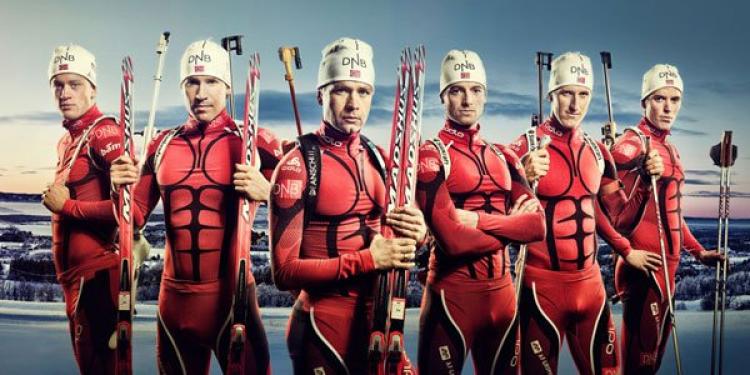In Norway Audiences Bet On Biathlon
Posted: January 7, 2015
Updated: October 6, 2017

Skiing cross country as fast as you can pausing only to shoot at targets a few inches wide over a hundred and fifty feet away is what the biathlon is all about, and Norwegians love it
I should probably, if only in pursuit of full disclosure, make it clear at the outset that skiing and I do not have a very happy relationship. My one experience of attempting to swish gracefully down the snowy slopes left me bruised, battered, suffering from concussion and harboring a life-long mistrust of fluorescent anoraks and the people who wear them. The piteous look of the chalet maid, the eye roll of my instructor, the knowing smirk of the ambulance driver, none of it endeared me to the sport.
Of course skiing is enjoyed by millions around the world and whilst a fair few of them are just tourists taking advantage of the slopes for their holidays, enjoying the apres ski and being able to swank about it upon their return home, for the professionals and their fans skiing is a harsh sport with a multitude of disciplines that range from the hugely impressive ski jumpers to the hot-dogging mogulers. But for sheer endurance, stamina, concentration and skill there's nothing to rival the biathlon.
Possessing an inherent inability to stand upright on skis on flat ground, let alone any sort of incline, I'm abjectly impressed with the amount of energy and effort the biathlon requires of its participants. Skiing massive distances across the undulating landscape pausing only to shoot at distant tiny targets and then rush off again, is a challenge of both the muscles and mind, the drive and focus necessary immense, but it is a sport at which the Norwegians excel and that is reflected in its popularity.
In Norway the biathlon regularly garners television audiences larger than thise for soccer, the most popular sport in the world, and they avidly follow every thigh-pumping, trigger-pulling moment of the various competitions within the sport, the stars lauded like rockstars and treated as such by Norwegian fans who turn out in massive numbers throughout the season to watch these highly trained athletes compete against each other in one of the toughest sports challenges the world has to offer.
No one was gambling news of its return would prove so popular with it quickly becoming a favorite with television audiences of the games. The World Championships likewise proved to be a big hit not just in Norway but throughout the world with the six different competitions within the sport giving a great range of different spectacles for the crowds and a sport that was so wonderfully suitable to split screen television presentation that had been developed for the coverage of major darts tournaments.
The individual event is the oldest with a 20km (12 miles) race of usually four laps around a circuit with each lap requiring each competitor to shoot five targets, half prone, half standing. Missing targets incurs a penalty of a minute and the competitor with the least time taken at the end wins. The targets are fifty meters or 160 feet away and are 1.8 inches (45 millimeters) wide when they're shooting prone and 115mm or 4.5 inches wide when they're standing.
The mass start event is as it sounds and can be a tangle of skis and guns as they attempt to race 15km (9.3 miles) with that distance penalty for misses during the four shooting bouts with some tricky lane rules that change as the race proceeds, keeping competitors mentally as well as physically challenged throughout. During the World Cup Mass starts only the top 30 competitors begin together to avoid congestion, but it's still a sight to see, especially if you partake of a little internet betting in Norway to back your favorite to win.
Indeed the Men's World Cup is one of the most heavily backed of the winter sports with sites like ComeOn! Sportsbook running dedicated books that provide regularly updated odds on the outcome of the season's events, and despite Norwegian gambling laws being somewhat out of step with the modern world that doesn't stop the internet providing a way and means for fans to enjoy the thrill of the Biathlon World Cup. Right now ComeOn! Sportsbook is offering a rather nice 1.57 on Martin Fourcade, with Emil Hegel Svendsen just behind on 3.30, Anton Shipulin at 7.25 and Johannes Boe distant at 15.50.
Of course it's an sport full of surprises and the Norwegian fans will tell you that there no sure things in the world of biathlon where a lack of breathing control can lead to a missed shot and can mean the difference between victory and second place. So the next time you're struggling to remember which of your many pockets you put your ski-lift pass in, and mutter about the noise of drunken revelers outside your chalet at 3am, spare a moment to think of the marvel that is the biathlon, the endurance sport with breaks for accuracy.
I should probably, if only in pursuit of full disclosure, make it clear at the outset that skiing and I do not have a very happy relationship. My one experience of attempting to swish gracefully down the snowy slopes left me bruised, battered, suffering from concussion and harboring a life-long mistrust of fluorescent anoraks and the people who wear them. The piteous look of the chalet maid, the eye roll of my instructor, the knowing smirk of the ambulance driver, none of it endeared me to the sport.
Of course skiing is enjoyed by millions around the world and whilst a fair few of them are just tourists taking advantage of the slopes for their holidays, enjoying the apres ski and being able to swank about it upon their return home, for the professionals and their fans skiing is a harsh sport with a multitude of disciplines that range from the hugely impressive ski jumpers to the hot-dogging mogulers. But for sheer endurance, stamina, concentration and skill there's nothing to rival the biathlon.
Possessing an inherent inability to stand upright on skis on flat ground, let alone any sort of incline, I'm abjectly impressed with the amount of energy and effort the biathlon requires of its participants. Skiing massive distances across the undulating landscape pausing only to shoot at distant tiny targets and then rush off again, is a challenge of both the muscles and mind, the drive and focus necessary immense, but it is a sport at which the Norwegians excel and that is reflected in its popularity.
In Norway the biathlon regularly garners television audiences larger than thise for soccer, the most popular sport in the world, and they avidly follow every thigh-pumping, trigger-pulling moment of the various competitions within the sport, the stars lauded like rockstars and treated as such by Norwegian fans who turn out in massive numbers throughout the season to watch these highly trained athletes compete against each other in one of the toughest sports challenges the world has to offer.
Military Origins Of The Sport
The origins of the biathlon hail from Norway where regiments of the army would stage competitions that made use of the unique skills required of troops in such a mountainous and winter ravaged country of northern latitudes. This consisted of several events that spawned a lineage that we can see much evidence of in the winter sports we watch today with perhaps the most dramatic being the shooting at small targets whilst skiing at top speed, although the racing between trees sounds quite the challenge too.Biathlon World Cup BettingThe mixture of long distance cross country skiing, with all its inherent physical requirements with the need to suddenly stop, control your breathing and shoot from various stances at remarkably small targets some distance away, first entered the Winter Olympics in 1924 under the somewhat gauche name of Military Patrol, and was deemed not to involve enough nations to warrant repeating. Indeed it wouldn't be until 1960 after the soviet take up of the sport it would return to the five-ringed circus.
• Cross country skiing with ammunition
• Long .22 rimfire used over 160 feet
• Bet on the cup winner at ComeOn! Sportsbook
No one was gambling news of its return would prove so popular with it quickly becoming a favorite with television audiences of the games. The World Championships likewise proved to be a big hit not just in Norway but throughout the world with the six different competitions within the sport giving a great range of different spectacles for the crowds and a sport that was so wonderfully suitable to split screen television presentation that had been developed for the coverage of major darts tournaments.
The individual event is the oldest with a 20km (12 miles) race of usually four laps around a circuit with each lap requiring each competitor to shoot five targets, half prone, half standing. Missing targets incurs a penalty of a minute and the competitor with the least time taken at the end wins. The targets are fifty meters or 160 feet away and are 1.8 inches (45 millimeters) wide when they're shooting prone and 115mm or 4.5 inches wide when they're standing.
Sprints, Relays and Mass Starts
In the sprint event the stagger start 10km ski is broken up by just two opportunities to shoot five targets, once prone, once standing with each missed target requiring the competitor to ski around a 150m loop before continuing. The pursuit event often sees the starting positions ranked on a previous competition such as a sprint with a 12.5 km ski interrupted by four shooting bouts of five targets each with a similar distance penalty for misses, and the added excitement of first-come-first-serve shooting lane choices. The relay and mixed relay events add a team aspect to the sport.The mass start event is as it sounds and can be a tangle of skis and guns as they attempt to race 15km (9.3 miles) with that distance penalty for misses during the four shooting bouts with some tricky lane rules that change as the race proceeds, keeping competitors mentally as well as physically challenged throughout. During the World Cup Mass starts only the top 30 competitors begin together to avoid congestion, but it's still a sight to see, especially if you partake of a little internet betting in Norway to back your favorite to win.
Indeed the Men's World Cup is one of the most heavily backed of the winter sports with sites like ComeOn! Sportsbook running dedicated books that provide regularly updated odds on the outcome of the season's events, and despite Norwegian gambling laws being somewhat out of step with the modern world that doesn't stop the internet providing a way and means for fans to enjoy the thrill of the Biathlon World Cup. Right now ComeOn! Sportsbook is offering a rather nice 1.57 on Martin Fourcade, with Emil Hegel Svendsen just behind on 3.30, Anton Shipulin at 7.25 and Johannes Boe distant at 15.50.
Of course it's an sport full of surprises and the Norwegian fans will tell you that there no sure things in the world of biathlon where a lack of breathing control can lead to a missed shot and can mean the difference between victory and second place. So the next time you're struggling to remember which of your many pockets you put your ski-lift pass in, and mutter about the noise of drunken revelers outside your chalet at 3am, spare a moment to think of the marvel that is the biathlon, the endurance sport with breaks for accuracy.
Related content
Subscribe
0 Comments












